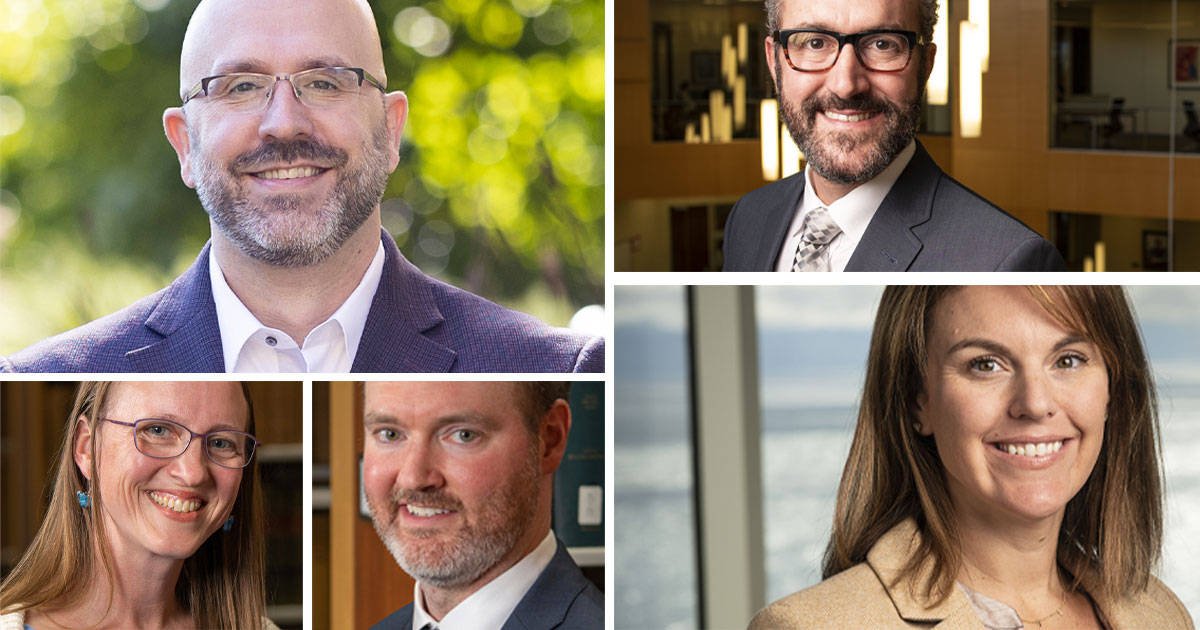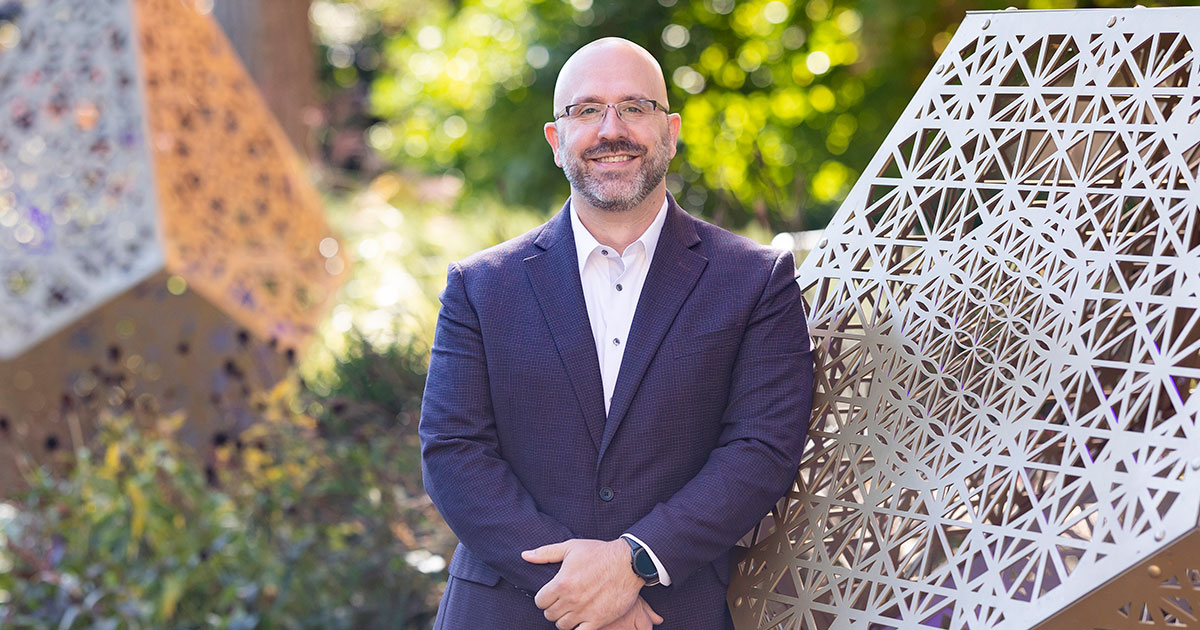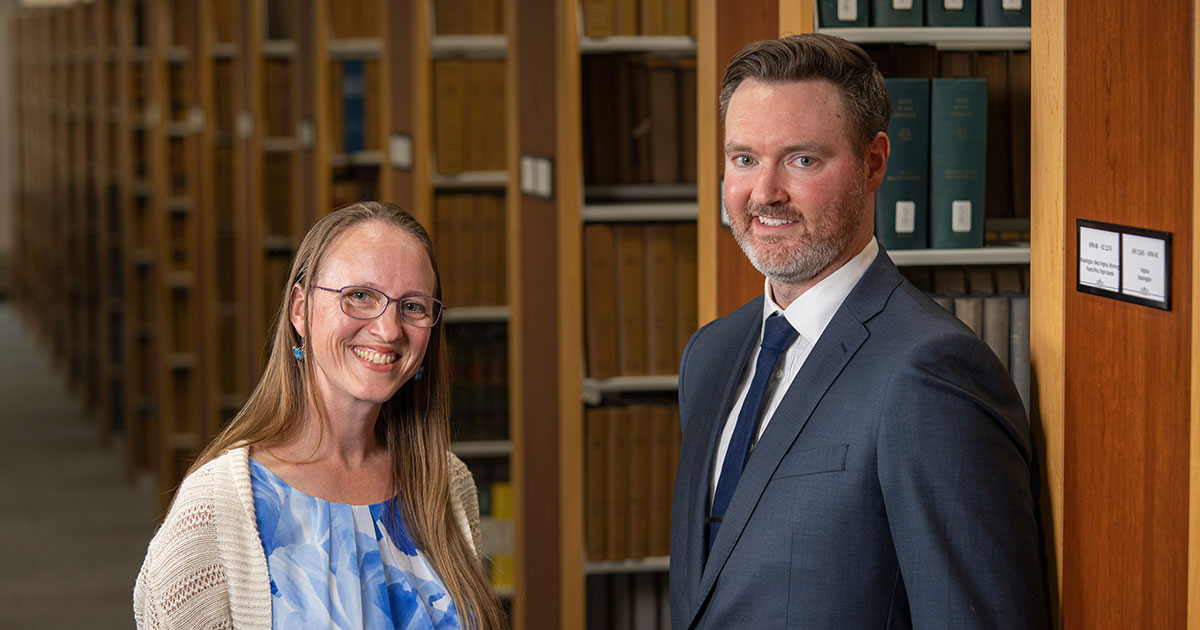
Creators of an easy-to-access digital version of the official Wisconsin jury instructions, an online platform with free legal forms and information for neighborhood entrepreneurs, and a commercial document review system powered by artificial intelligence are among the recipients of the Wisconsin Lawyer Legal Innovator awards for 2022.
The fourth winner, Lifetime Legal Innovator Michael Rust – former CEO at the Winnebago Conflict Resolution Center and now a court commissioner in Winnebago County – built a career innovating how people access mediation services in Winnebago County, across Wisconsin, and beyond.
The State Bar of Wisconsin began the legal innovators project nine years ago and has found over time that legal innovation comes in many forms. This year’s nominees are no different in that regard, says Tom Watson of the State Bar of Wisconsin Communications Committee’s Legal Innovation Subcommittee.
“We look for lawyers and law firms that are approaching challenges in unique ways,” he says. “It might be using technology in ways we have not seen in the past or finding a way to provide access to legal services to segments of our community that otherwise would not have that access or maybe creating a program that did not exist before so that more people can get the help they need.”
By recognizing nominees who go beyond the norm in how they serve their clients and develop new ways to fill needs in their communities, the State Bar has highlighted lawyers who thrive in the ever-changing and highly competitive legal marketplace, Watson says.
“We know that clients are more sophisticated than ever before, and their expectations for client service, information, and accessibility continue to rise,” he says. “And there are still plenty of unmet legal needs out there. It’s up to our profession to figure out ways to help those people. It means utilizing technology, developing new systems and procedures to better serve clients, and figuring out ways to make information more easily accessible.”
Lifetime Innovator Michael Rust: Empowering Parties in Mediation to Devise Resolutions

Michael Rust, this year’s Lifetime Legal Innovator, has built a career helping mediating parties devise resolutions. In the wake of COVID-19, Rust, as CEO of the Winnebago Conflict Resolution Center, moved mediation services online. He leveraged the Zoom platform because it allowed for breakout rooms, the ability to virtually sign documents, and mobile or telephonic access. Partnering with UW-Madison’s Division of Extension, he developed an online mediation training program offered to other jurisdictions and privately for colleges and companies. Rust, pictured here at the Paine Art Center and Gardens in Oshkosh, has gained local and international renown for his mediation work. He is now a Winnebago County court commissioner. Photo: Colleen Bies
Michael Rust, who served as CEO of the Winnebago Conflict Resolution Center from 2013 until he became a court commissioner in July 2022, has continuously searched for ways to give the parties to mediation the ability to devise their own resolutions, which both empowers them and eases the load on the court system.
This theme for his career took hold early on, as one of the students who co-founded the Restorative Justice Initiative at Marquette University Law School with retired Wisconsin Supreme Court Justice Janine Geske. “She wanted to teach lawyers how to find resolutions and help people on a more holistic level,” Rust says. “Even on the criminal court level, is there a way we can resolve the harm caused by the crime? It was an opportunity to learn from a very talented mediator about some of the ways that work can be done.”
As a law student, he also participated in the American Bar Association’s mediation advocacy competition and placed third in the world at the International Chamber of Commerce’s mediation competition. Rust handled corporate and real estate litigation work for a few years after law school, but he knew that he wanted his career to tack toward mediation from the beginning. “I got tired of feeling like I was causing conflict and wanted to actually resolve it,” he says.
After working as a private mediator for a couple of years, he was hired to lead the Winnebago Conflict Resolution Center. During Rust’s tenure, the center extended its reach to Fond du Lac County and expanded from primarily small-claims mediation to include bankruptcy, special education, and other civil mediation. The center also began providing foreclosure mediation for an eight-county area and ramped up speaking and training offerings, Rust says.
In the wake of COVID-19, Rust shifted the provision of mediation services to online dispute resolution – and then helped other centers, systems, and mediators do the same by training mediators. The move online was a necessity that rose once the court system reopened to begin holding cases virtually, he says. “I realized there was a lot of strain on the court system because mediators weren’t able to do their work.”
Rust leveraged the Zoom platform because it allowed for breakout rooms – a key feature in mediation – as well as the ability to virtually sign documents if all parties were amenable. In addition, the platform allowed for both mobile access and, if necessary, the ability to call in by telephone. “Access was a big consideration,” he says. “I didn’t want to disenfranchise anybody based on the inability to have a connection.”
Because Rust couldn’t handle all the needed mediations himself, he encouraged mediators to take additional training on how to use the online tools and handle ethical issues that arose in an online platform. In conjunction with UW-Madison’s Division of Extension, he led the development of an online mediation training program offered to other jurisdictions, as well as privately for colleges and companies looking to have mediators trained.
He encourages parties to cases to consider mediation whenever possible, noting that it can be done at the parties’ convenience, moves matters more efficiently, and typically results in greater compliance. “Having the parties take ownership results in a solution that the parties will actually follow through on, as opposed to having someone tell them what to do,” Rust says. “There are far fewer enforcement issues on the back end.”
Among Rust’s other mediation-related involvements have been serving as president of the Wisconsin Association of Mediators, chair of the State Bar of Wisconsin’s Dispute Resolution Section, president of the international Association for Conflict Resolution (the second person from Wisconsin to do so), inaugural co-chair of the Civil Legal Aid Alliance of Wisconsin, and mediation partner for the Wisconsin Special Education Mediation System.
Rust has spoken at conferences from the local to the international levels and has gained renown for his mediation work in areas such as harassment restraining orders, victims and offenders, eviction prevention, special education, guardianship, and elder law. His speaking engagements and other involvements have resulted in some Winnebago Conflict Resolution Center innovations being adopted in other states, including Ohio, Maryland, and Florida.
“Michael’s commitment to helping find ways to better utilize mediation services has not only made our profession better, but has also helped many people resolve issues and get the results that can improve their lives,” Watson says.
Rust recognizes the irony in recently becoming a court commissioner, where his caseload comprises primarily family law, small claims, and restraining order matters – a similar array to the types of cases he’s mediated. “I had spent my career talking about how we all needed to stay away from judges and see if we could resolve things without needing to involve the courts,” he says. “I thought, ‘If these are the same types of cases, and I’ve been telling people they should resolve their cases – that I could learn more about what courts do, and do it in a way that maybe people don’t want to stay away from the courts.’ ”
Office of Judicial Education & Wisconsin State Law Library: Free All-Digital Jury Instructions

Carol Hassler, librarian and website developer at the Wisconsin State Law Library, and Bryce Pierson, legal advisor to the Office of Judicial Education in the Director of State Courts Office, partnered to create free all-digital jury instructions. The resource is user friendly for lawyers, judges, and laypeople, including self-represented litigants, removing barriers to access and allowing for faster updates and greater search efficiency. Instructions related to the elements of an offense, defense, or claim, along with footnotes and commentary, can be accessed on a computer, smartphone, or tablet. Photo: Andy Manis
Before early 2021, access to the official Wisconsin jury instructions was limited to purchasers of subscriptions to annual supplemental releases, along with a smattering of law libraries around the state. But in February 2021, an all-digital version created through a partnership of the Office of Judicial Education in the Director of State Courts Office and the Wisconsin State Law Library went live at https://wilawlibrary.gov/jury/.
Available for free to anyone with an internet connection, the resource was designed to be user friendly for not only lawyers and judges but also laypeople, including self-represented litigants, removing daunting barriers to access and allowing for faster updates and greater search efficiency. Instructions, along with footnotes and commentary, can be accessed on a computer, smartphone, or tablet.
By September 2022, the instructions had been accessed more than 27,000 times per month, for a total of 550,000 visits. This includes visits to the Children’s, Civil, and Criminal contents summaries, subject indices and tables, and individual instruction pages but not access made via direct links to PDF and Word file downloads.
The official Wisconsin jury instructions had been published and maintained at the U.W. Law School for many years. Wisconsin was innovative when it created and started updating jury instructions in the late 1950s but eventually fell behind other states in terms of taking down barriers to access. In early 2020, the online jury instruction concept took root in the Director of State Courts Office, says Bryce Pierson, legal advisor there, who partnered with Carol Hassler, librarian and website developer at the Wisconsin State Law Library, to set up the free, online version.
The state of Georgia had a similar model to Wisconsin in terms of being a for-profit enterprise and updating bound volumes each year. A lawsuit against Georgia spurred the University of Wisconsin, which had produced the updated volumes, to decide to shift to a nonprofit model after years of collecting fees, Pierson says. That meant the U.W. Law School needed a partner. It also needed funding because at around the same time, the pandemic hit, and the project was “on the chopping block,” he says.
The U.W. Law School communicated with the Director of State Courts Office to say that the jury instructions project needed to continue in some form, given how much it was relied on by laypeople despite relative inaccessibility as a print and CD product. With assistance from the Wisconsin State Law Library, the decision was made to create a digital version, Pierson says.
“Whether it’s a judge familiar with the instructions or somebody who’s never had interactions with the court system, they’re guided to this website, and they’re able to conduct a keyword search, and they’re able to look for statutes that they don’t really know,” he says.
Hassler says that the partners surveyed what other states had done in terms of online access and found a wide range, from a fully commercial document management system to a single PDF file. They approached the project thinking about it as users of jury instructions, she says. “We wanted something easy to get into and linkable,” she says. “You can link to a single instruction and get people all the information they’re going to need.” They kept the paper versions and will do so for the foreseeable future because some people prefer paper versions and it’s important for libraries to have archives of older instructions, she adds.
Taking apart physical books and turning them into a data structure was a challenge even for someone who works with data regularly, Hassler says. “What are the essential fields you need? You can pull key elements from a citation, identify what are the main things we need to track? … That was part of the challenge, trying to look at a print publication in a slightly different way, while still supporting a print publication.”
Pierson says that getting the word out to laypeople that the resource is available to them has proved to be a challenge, as has the noticeable trend toward for-profit entities scrubbing the free resource and repurposing the content – but not always in a timely manner, which means a layperson might be accessing dated instructions. “That takes up a court’s time,” he says. “We’ve been trying to work with outside entities that utilize this resource, making sure everything is updated at the same time.”
Among the advantages of online instructions that contain individual landing pages for each instruction is the ability to track usage data, Hassler says. “As librarians, it helps us understand the types of issues people are researching so we can be ready to answer questions,” she says. “We’ve charted a slow and steady rise in the use of our jury instructions pages, for all three sets; civil and criminal tend to be a little higher use. We have seen a steady increase in people keyword searching into a citation. It’s been good to see the flow of data, and how people are traveling to that information, and the related instructions when they get there.”
Marquette Law and Entrepreneurship Clinic: Free Online Forms for Neighborhood Entrepreneurs

Nathan Hammons, a clinical associate professor at Marquette Law School, directed the Marquette Law and Entrepreneurship Clinic’s effort to provide free legal information and basic business forms online for neighborhood entrepreneurs – people who have great business ideas and passion but who lack both a knowledge of business law and the capital to afford a private attorney. In January 2022, the clinic launched the BUILD platform. BUILD covers business-related topics, and the free document generator serves up state-specific legal forms. To determine what the site should offer, Hammons sought input from business support groups on what their clients need and their top legal concerns. Photo: Kevin Harnack
Neighborhood entrepreneurs with great business ideas and passion – who lack both a knowledge of business law and the capital to afford a private attorney – are the target audience of an effort by the Marquette Law and Entrepreneurship Clinic to provide free legal information and basic business forms online.
Directed by Nathan Hammons, a clinical associate professor at Marquette Law School, the clinic in January 2022 launched the BUILD platform (https://law.marquette.edu/build/) with a $35,000 grant from the Wisconsin Economic Development Corporation, aimed at small businesses at a time when the gaps in knowledge and access have widened due to the COVID-19 pandemic and social unrest.
BUILD covers legal topics such as business structures, employment law, finance, intellectual property, business contracts, and licensing and permitting, while the free document generator serves up state-specific legal forms including LLC operating agreements, employee offer letters, independent contractor agreements, and nondisclosure agreements.
While the site could serve Silicon Valley startups in addition to neighborhood entrepreneurs, the former already have access to similar resources created by large law firms for marketing and client development purposes, Hammons says. “That’s what prompted the idea,” he says. “If those businesses have access to good, free legal forms, something could and should be created for your neighborhood entrepreneurs.”
Lacking their own understanding of business law basics or access to the services of a private attorney means these would-be entrepreneurs turn to Google, which randomly sends them around the internet. “Which, no surprise, is just replete with poor legal documents,” he says. “We would frequently, in our clinic, see clients who had gotten for free, or even paid for, legal forms online, and they were poor legal agreements, or not suitable for their business, at all.”
To determine what the site should offer, Hammons sought the counsel of business support groups: the Small Business Development Center at the University of Wisconsin-Milwaukee; BizStarts, a Milwaukee-based nonprofit; and the Wisconsin Women’s Business Initiative Corporation, a micro-finance lender, Hammons says. “Just to get their input on what their clients need, [and] their top legal concerns,” he says. “That gave me ideas, plus my own experience working with entrepreneurs through the clinic.”
One challenge in creating the resource was finding a solid, affordable platform for document automation, Hammons says, adding that the clinic turned to a service called Documate. “They’ve been very supportive of efforts by legal aid organizations and law schools, and they’re able to offer a significant discount,” he says.
To those considering such a project, Hammons has a bit of advice: “Build it,” he says. “It’s a wonderful thing about the internet: You can provide easy access to great legal information and forms that somebody can access on their mobile device or computer. You can put it right at their fingertips. It’s frustrating when I see clients who have paid a lot of money and find a poor legal form that doesn’t support their business. I want the law to be a tool for these small business owners, as opposed to a barrier.”
The clinic is still tabulating data on numbers of visits and downloads, but qualitatively, “We’ve had very positive feedback,” Hammons says. “If anything, they’d like to see us expand and add more legal forms. We plan to do that in the coming months. … Attorneys are welcome, if they encounter clients who can’t afford their services, to direct them to this resource.”
Foley & Lardner: AI-Powered Review of Commercial Contracts

Kate Wegryzn, a partner in the Milwaukee office of Foley & Lardner, led a project with Jacksonville-based partner Chanley Howell to develop the Foley Equipped artificial intelligence-powered system to review commercial contracts. The system results in a more efficient and cost-effective document review process, streamlining analysis, review, and revision. The platform is “trained” to identify categories of interest within a document, flag high-risk clauses and those outside commercial-contract norms, and highlight missing terms, among other functions. A team of about 15, including attorneys, marketers, and information technology specialists, spent more than 500 hours developing the platform. Photo: Kevin Harnack
The review of commercial contract documents can be time consuming to the point of overwhelming many organizations, which means either the documents aren’t thoroughly reviewed or the process creates a time-suck for lawyers, drawing them away from higher-value efforts.
Foley & Lardner in November 2021 rolled out an artificial intelligence (AI)-powered document review system for certain clients that results in a more efficient and cost-effective process, streamlining analysis, review, and revision, the firm says. The Foley Equipped platform, which can be used by in-house counsel or Foley’s own attorneys depending on a client’s needs, was made more widely available in June.
“We were hearing from clients over and over again that they were having a hard time keeping up with the volume of contracts they were receiving,” says Kate Wegryzn, a partner in the Milwaukee office, who co-led the project with Jacksonville-based partner Chanley Howell. “They get this influx of commercial contracts to review, that they’re expected to review at a pretty quick clip. We couldn’t think of a solution that didn’t involve some element of AI, given the volume and length.”
The platform is “trained” based on Foley attorneys’ commentary to identify categories of interest within a document, flag high-risk clauses and those outside commercial-contract norms, and highlight missing terms. The review and implementation of revisions uses a Microsoft Word plug-in, an added benefit that enables the user to easily infuse the firm’s sample clauses – or the client’s own preferred language – with a few clicks.
Foley added value by training the AI with “best-in-class legal advice,” she says. “As the client or the lawyer continues to mark up the agreement, it acts like a checklist to make sure you’re maintaining quality control. You can drop language in at the click of a button. Those little efficiencies add up over time to real-time savings. And especially for our junior attorneys internally, having that tool with our advice baked into it has been a valuable training, quality control, and efficiency tool.”
 Ed Finkel is an Evanston-based
freelance writer.
Ed Finkel is an Evanston-based
freelance writer.
More than 500 hours went into development of the platform by a team of about 15 people, including attorneys – partners and associates – as well as marketers and information technology specialists in Foley’s Milwaukee and Jacksonville, Fla., offices, who leveraged the technology from document review system provider ThoughtRiver.
The main challenge has been educating attorneys about the benefits of AI – while tamping down incorrect notions about its potential drawbacks, Wegrzyn says. “There seem to be two camps of AI,” she says. “A lot of lawyers are a little leery of it: ‘Is it going to take over my job?’ That’s one camp. It definitely is not. This is not even close to the stage of being able to replace a lawyer.”
The second camp doesn’t trust or believe that AI could perform start-to-finish document review, which has at least some grains of truth to it, Wegrzyn says. “It’s getting them comfortable with [the idea that], this is a tool. It’s going to work alongside us,” she says. “We’re not trying to replace a lawyer.”
Another challenge was the time spent on the project, which surpassed Wegrzyn’s already high expectations. “I knew it would take a lot of hours. It took way more than I ever anticipated,” she says. “It’s been a challenge from a resource perspective to make sure we dedicated the proper hours. A lot of in-house teams would not have 500 to 700 hours, and most in-house counsel don’t have the kind of time to dedicate to a project like that.”
The system has incorporated sales contracts and confidentiality agreements in the last month or two, Wegrzyn says. “We will continually add to it,” she says. “The long-term plan is to integrate it with Foley’s other technologies and make it all one suite of technology, with contract management and document population.”
Foley purposely rolled out the system slowly, to ensure it had the resources to devote to everyone, Wegrzyn says. “It’s getting increasingly used internally. Our own lawyers are using it more and more,” she says. “Clients are really excited about it.”
» Cite this article: 95 Wis. Law. 34-40 (November 2022).
